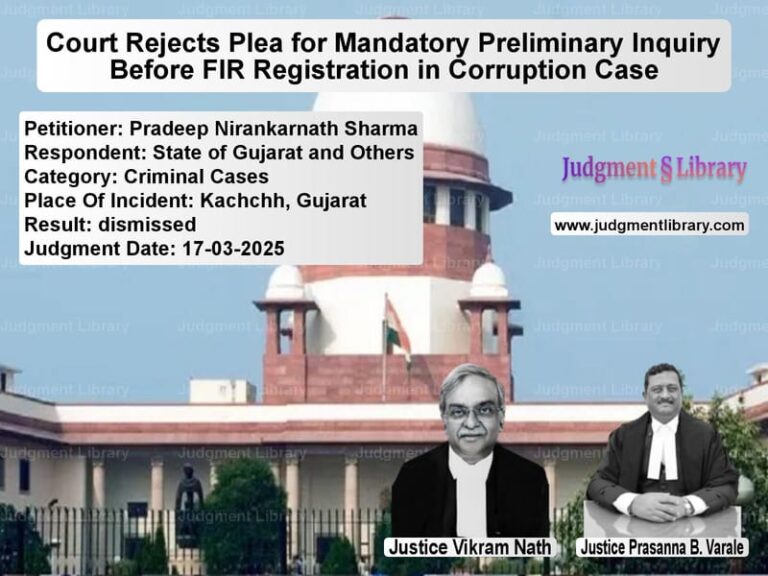Supreme Court Rules on Dual Tax Benefits for Cement Sales in Rajasthan
The case of J.K. Lakshmi Cement Ltd. v. Commercial Tax Officer, Pali addresses the eligibility of a cement manufacturer for dual tax benefits under two separate government notifications in Rajasthan. The Supreme Court ruled against the appellant’s claim for simultaneous exemptions, reinforcing the principle that tax benefits cannot be availed under overlapping schemes unless explicitly allowed by law.
Background of the Case
J.K. Lakshmi Cement Ltd., a public limited company, is engaged in the manufacture and sale of Grey Portland Cement. The dispute arose over the interpretation and applicability of two tax exemption notifications:
- Notification No. F4(72)FD/Gr.IV/81-18, dated 06.05.1986, which allowed partial exemptions from sales tax on inter-State sales.
- Notification No. F4(8)FD/GR.IV/94-70, dated 07.03.1994, which prescribed a concessional Central Sales Tax (CST) rate of 4% on inter-State cement sales without the requirement of furnishing Form C.
The dispute primarily revolved around whether the appellant could claim benefits under both notifications for the same financial year.
Key Legal Issues
- Could the appellant claim simultaneous tax benefits under both notifications?
- Did the Rajasthan Government’s circulars and notifications clarify or restrict such dual benefits?
- Was the retrospective withdrawal of tax benefits valid under the law?
Arguments from the Appellant (J.K. Lakshmi Cement Ltd.)
- The appellant contended that both notifications aimed at promoting inter-State trade and should be interpreted harmoniously.
- It argued that the benefit under the 1986 notification was linked to increased inter-State sales, while the 1994 notification provided a separate tax concession, making them mutually compatible.
- The appellant also relied on previous government circulars that had allowed similar tax benefits in earlier years.
Arguments from the Respondent (Commercial Tax Officer, Pali)
- The tax authorities argued that the 1994 notification expressly prohibited claiming benefits under the earlier 1986 notification.
- They emphasized that tax benefits must be claimed strictly per the conditions set forth in government notifications.
- The respondent maintained that allowing dual benefits would distort tax calculations and lead to revenue loss.
Supreme Court’s Judgment
1. Interpretation of Tax Exemption Notifications
The Supreme Court held that:
“The language of the 1994 notification is clear and unambiguous. A dealer making inter-State sales under this notification is ineligible to claim benefits under the 1986 notification.”
The Court rejected the appellant’s argument that both notifications should be interpreted to allow simultaneous benefits, emphasizing that tax exemptions must be strictly construed.
2. No Dual Tax Benefits Allowed
The Court found that allowing the appellant to claim benefits under both notifications would violate the policy intention behind the tax exemptions. It ruled:
“A dealer making inter-State sales at a concessional rate of tax under the 1994 notification cannot simultaneously claim the partial tax exemption under the 1986 notification.”
3. Validity of Government Circulars
The Court upheld the validity of a 2001 government circular that clarified the non-applicability of dual tax benefits, noting that administrative circulars interpreting tax laws are binding on tax officers but cannot override statutory provisions.
4. Rejection of Retrospective Claims
The appellant had claimed tax benefits for previous years based on earlier government interpretations. The Court ruled that:
“Tax benefits once granted under a misinterpretation of the law do not create a vested right. The appellant cannot claim a legitimate expectation based on erroneous past assessments.”
Final Ruling
The Supreme Court dismissed the appeal, upholding the Rajasthan High Court’s ruling that the appellant could not claim dual tax benefits under the two notifications.
Key Takeaways from the Judgment
- Tax exemptions must be strictly interpreted based on the language of the notification.
- Government notifications clearly restricting dual benefits must be followed.
- Tax benefits granted due to past misinterpretations do not create vested rights.
- Administrative circulars clarifying tax policies are binding but cannot override statutory provisions.
Conclusion
The Supreme Court’s ruling in J.K. Lakshmi Cement Ltd. v. Commercial Tax Officer, Pali clarifies the principle that tax exemptions cannot be availed simultaneously under conflicting government notifications. The judgment reinforces the need for strict adherence to tax laws and ensures that tax policies are applied uniformly to prevent undue revenue losses.
Don’t miss out on the full details! Download the complete judgment in PDF format below and gain valuable insights instantly!
Download Judgment: J.K. Lakshmi Cement vs Commercial Tax Offic Supreme Court of India Judgment Dated 16-09-2016-1741883740244.pdf
Direct Downlaod Judgment: Direct downlaod this Judgment
See all petitions in Tax Refund Disputes
See all petitions in Income Tax Disputes
See all petitions in Customs and Excise
See all petitions in Judgment by Dipak Misra
See all petitions in Judgment by C. Nagappan
See all petitions in dismissed
See all petitions in supreme court of India judgments September 2016
See all petitions in 2016 judgments
See all posts in Taxation and Financial Cases Category
See all allowed petitions in Taxation and Financial Cases Category
See all Dismissed petitions in Taxation and Financial Cases Category
See all partially allowed petitions in Taxation and Financial Cases Category







